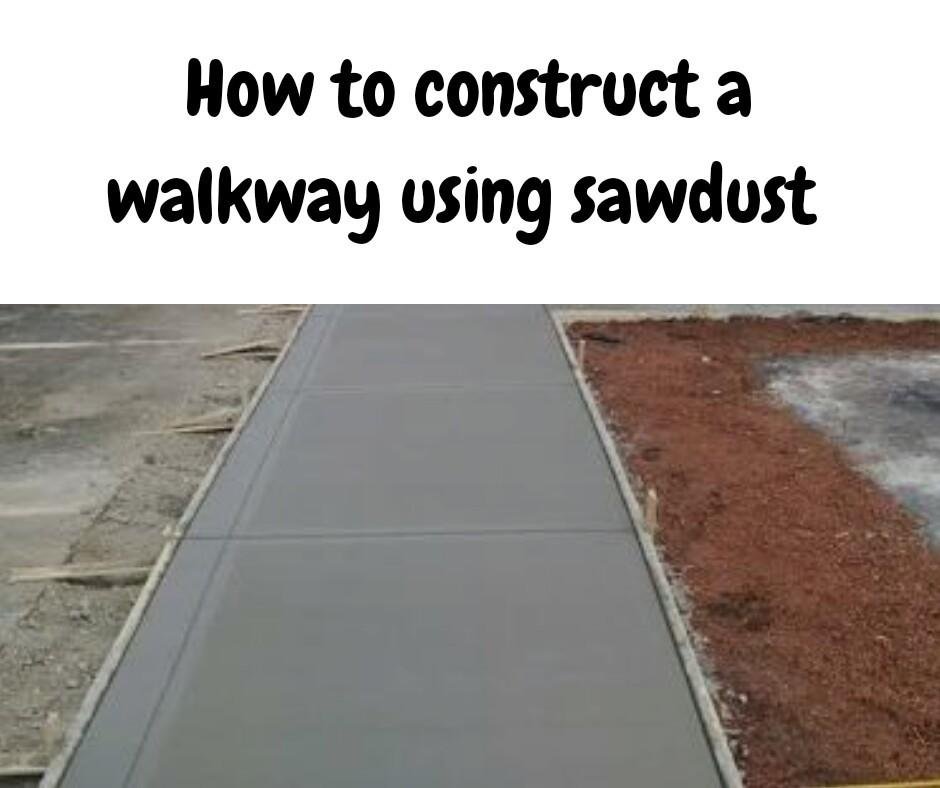
Hello hive community, today I will like to share an explanation on how to construct a walkway using sawdust as partial replacement of sand, a walkway is passage or path for walking along, especially a raised passageway connecting different section either in a roadside in a park or in a building, this was a project assigned to me and my group in school, which i will try to give you a better understanding on how this was carried out, the idea of using a sawdust was brought up by a senior lecturer in civil engineering department in my institution 5 years ago, which the project was carried out successfully.
Introducing sawdust
Sawdust was actually used in the construction as a partial replacement to reduce the cost of carrying out the walkway project, the sawdust which was seived to remove the large particles, which may form any void that can result to cracking of the walkway pavement and also allow the proper setting and hydration of cement.
A concrete is made up of cement, water and aggregate (fine and coarse type). other constituents may be added such as admixture, pigment polymer and reinforcement for additional strength and aesthetic.
The properties in concrete which includes the workability, shrinkage, thermal expansion, compression, tensile stresses.
Aggregate occupies about 70-75% of the volume of concrete and the selection of the coarse and fine aggregate which influence the properties of fresh and hardened concrete.
Below are the steps taken during the construction.
1. Preparation
All the equipments and materials were ready at the construction site such as:
- Concrete mixer
- Headpans
- Shovel
- Diggers
- Wheelbarrows
- Handtrowels
- Leveling staff
- Dumpy level
- Measuring tape
- Ranging pole
- Mould
The construction materials used during the construction of the walkway are
- Water
- Cement
- Sand
- Sacks of Sawdust
- Granite
- Gravel
2. Excavation
The removal of the top soil was the next stage, when constructing it is necessary to remove the top soil so as to construct on a suitable base.
3. Cutting and filling
Moving to the next step, based on the results obtained from the levelling which was carried out with the Dumpy level, some portions were cut while others are filled, shovels were used to cut, after the hard portions were digged using Diggers.
4. Compaction
Compaction was also carried out to increase the dry density of the soil by artificially rearranging and packing into closer state contact under dynamic load, this reduces the shrinkage of the soil, increases the density of the bearing capacity and enables the road mobility of the soil, Compaction was carried out using rammer.
5. Moulding of kerbs
After providing plastic moulds, they were laid down, cleaned and lubricated with diesel, lubrication with diesel provide smooth body for the Kerbs and also for the easy removal from the mould.
Concrete was produced with aggregate ratio 1:2:4 with the use of concrete mixer. Sawdust was also used as a partial replacement for fine aggregate (sand).
A mix produced six Kerbs after setting, the Kerbs were removed from the moulds after which they were cured.
6. Laying of kerbs
The Kerbs were layed on both sides of the walkway, the Kerbs were joined together using motar(cement, sand, water) with 1:6 mix ratio. Some little space were left (about an inche) for easy passage of water to prevent excess water from the walkway which may lead to cracking.
7. Slump test
This is method was carried out to determine workability, the apparatus is not costly, as it is portable and robust and it is the simplest of all methods employed for measuring workability, it is suitable for wet mixes and not for very wet or dry mixes, it involves filling a standard Slump cone with the concrete mixed that was compacted by hand tapping and measuring the amount of slump ( in mm) after the cone has been carefully removed.
8. Spreading of concrete
The concrete was spread on the compacted surfaces with an initial thickness of 4 inches (100mm) which kept on reducing with the respect to slope of the area for free movement of water.
9. Screeding
This involves the smoothing of irregular surface to make it attractive and also filling of some holes with concrete, Screeding renders the area more attractive.
Conclusion
The construction of the walkway was carried out effectively. Concrete was basically used which was formed by mixing of cement, sand, Gravel, sawdust and water which has an equal quantity with the mixture of cement, sand, gravel and water.
This proves that the use of sawdust as a partial replacement of fine aggregate such as sand is more economical to the use of sand only in construction of the walkway, I recommend sawdust can be used as a partial replacement for sand in construction work.
Thanks for reading my post, hope this is useful, please upvote, reblog, comment and follow for more. once again thanks